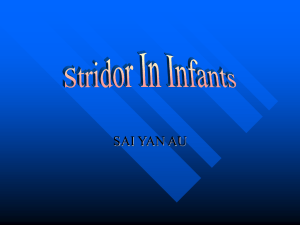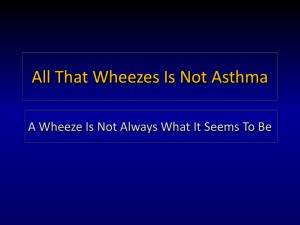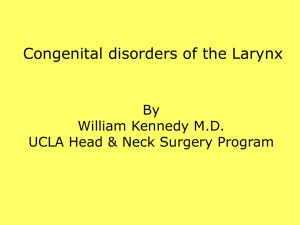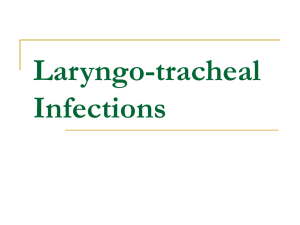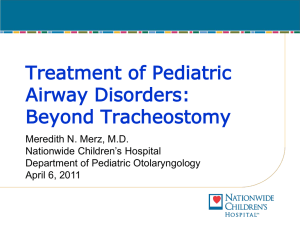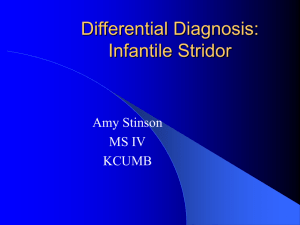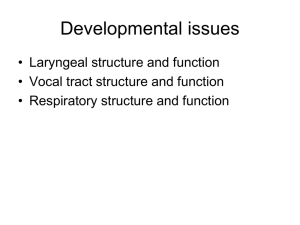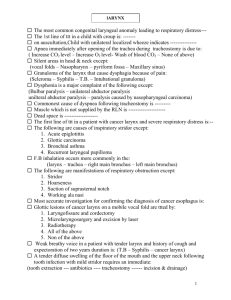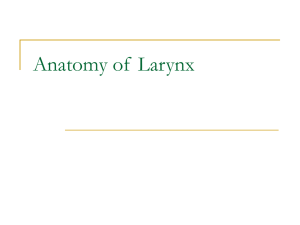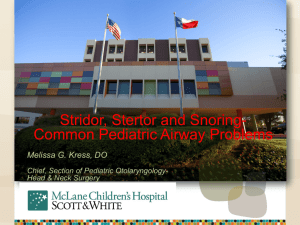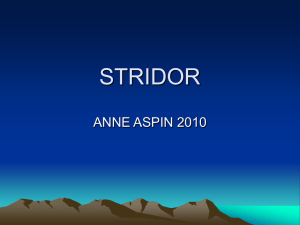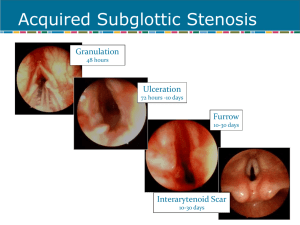Larynx_Congenital Anomalies of Larynx
advertisement
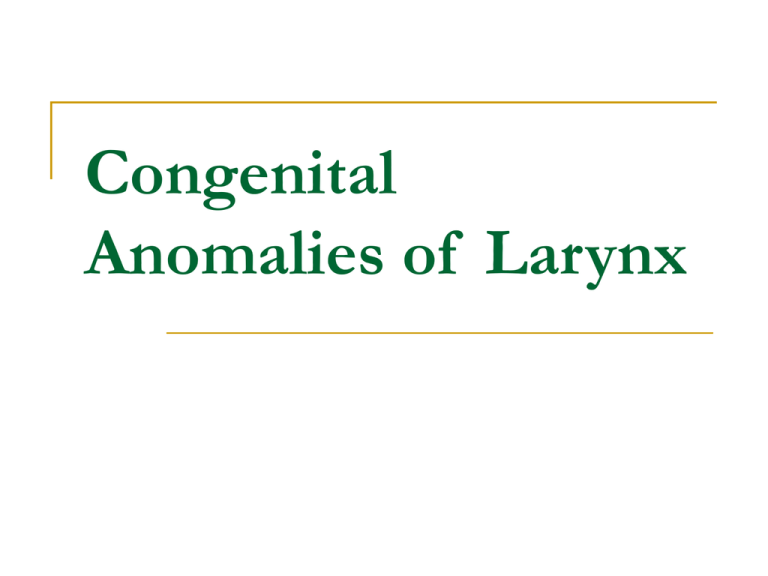
Congenital Anomalies of Larynx The larynx develops from the fourth and fifth branchial arches. At the third week of gestation, the respiratory primordium is derived from the primitive foregut to later form the lung bud and later the bronchial bud which will eventually develop into the tracheobronchial tree. At the fourth and fifth week of gestation the tracheooesophageal folds fuse to form the tracheo-oesophageal septum leading to the separation of the tracheal airway lumen from the esophageal digestive tract. Development of Larynx Larynx develops from the caudal hypobranchial eminence which later becomes the epiglottis and the cuneiform cartilages. Laryngotracheal groove is formed at the level of the 6th arch and its opening is further developed to become T shaped. On the sides of the ‘T’ will be the connection of the two arytenoids swellings. The arytenoid swelling later on become the arytenoid cartilages. The transverse groove forming the transverse bar of the T will form the ary-epiglottic folds and muscles together with the corniculate cartilages of the larynx. The laryngotracheal groove itself forms the respiratory tract. Its proximal end forms the trachea, the middle forms the bronchi while the distal forms the lungs. The pediatric Larynx The newborn larynx is about one third the size of the adult counterpart. The diameter of the subglottic and glottis are narrower which leads to an increase propensity for airway obstruction and compromise. The subglottic region is about 4 to 5 mm in diameter. The epiglottis is also narrower in infants. The larynx lies at the level of the third/fourth cervical vertebrae at birth. By fifteen years of age it has descend to the level of the sixth vertebrae. These dimensions leave little margin for obstruction in the infant, unlike the adult. The narrowest portion of the airway in the older child and adult is the glottic aperture, while the narrowest part of the airway in the infant is the subglottis. A diameter of 4.0 mm is considered the lower limit of normal in a full term infant and 3.5 mm in a premature infant. Indeed, an infant with one millimeter of glottic edema will experience a 35% obstruction of the airway. In the subglottis, one millimeter of circumferential edema leads to over 60% narrowing. Clinical Manifestations of congenital anomalies Respiratory obstruction Stridor Weak cry Dyspnoea Tachypnea Aspiration Cyanosis Sudden death The clinical presentation of each lesion varies from the site . The majority congenital lesions present with symptomatology in the neonatal period or during infancy. Laryngeal lesions typically present with stridor, hoarseness, aphonia, and possibly feeding disorders. The stridor is usually inspiratory or possibly biphasic in nature, Stertor, is primarily caused by airway obstruction in the nasal or pharyngeal regions. Supraglottic Abnormalities Laryngomalacia Most common congenital laryngeal anomaly. Accounts for approximately 60 percent of laryngeal problems in the newborn. Boys are affected twice as often as girls. It is usually a self-limiting condition, but when severe may produce: Life-threatening obstructive apnea, Cor pulmonale, Failure to thrive. Fatal outcomes have been described. Severe cases may require intubation or tracheotomy to secure the airway. Normal Larynx Collapse of arytenoid mucosa; shortened aryepiglottic folds; tubular epiglottis with posterior collapse The supraglottic structures are pulled into the lumen around a vertical axis with inspiration Laryngomalacia Condition arises from a continued immaturity of the larynx, as if the fetal stage of laryngeal development has persisted. The abnormality appears to be flaccidity or in- coordination of the supra-laryngeal cartilages, especially the arytenoids that is expressed when the infant is stressed by excitation with an increased respiratory rate. Stridor is typically noted in the first few weeks of life and is characterized by fluttering, high-pitched inspiratory sounds. Therapy consists of confirming the diagnosis by flexible laryngoscopy and reassuring the parents that the prognosis for the child is favorable. Position changes of the infant may help alleviate the stridor as it typically worsens in the supine position. In the past, tracheotomy was the surgical procedure of choice for severe cases. Supraglottoplasty has proven successful for the correction of supraglottic obstruction and is now the surgical procedure of choice. Supraglottoplasty Laryngocoele Dilated sac filled with air (ventricle) Internal vs. external May present at birth– stridor* Difficult to diagnose– CT? Endoscopic or open procedures Recurrences low Internal laryngocoeles are within the larynx itself and do not cross the thyrohyoid membrane. External laryngocoeles penetrate the thyrohyoid membrane at the neurovascular bundle. Mixed laryngocoeles are dilated in both segments. Treatment These are rare in infants and can cause intermittent hoarseness and dyspnoea that increases with crying. Diagnosis may be difficult as these can contract and may not be visualized under anesthesia. A CT may be valuable in these instances. Endoscopic and open procedures have been advocated depending on the size and location of the laryngocoele. Glottic Anomalies Laryngeal webs Failure of recanalization of larynx 75% at glottic level Most anterior with subglottic involvement Four types– increasing severity May present at birth Diagnosis: flexible laryngoscopy Airway films helpful with subglottis The presentation of laryngeal webs varies with the severity and type of the web. Type I laryngeal webs involve 35% or less of the glottis. The true vocal cords are visible through the web and there is little or no subglottic extension. Symptoms include a mildly abnormal cry with some hoarseness. Respiratory distress is usually not a feature. Type II webs are anterior webs involving 35-50% of the glottis. Subglottis involvement stems more from thick anterior webbing than from cricoid abnormalities. Airway symptoms are uncommon except during infection or after intubation trauma. Type III webs involve 50-75% of the glottis. The web is thick anteriorly and the true vocal cords may not be visualized. There may be associated cricoid anomalies. Airway symptoms are often severe and marked vocal dysfunction may occur. Type IV webs occlude 75-90% or more of the glottis. It is uniformly thick and the true vocal cord is not identifiable. The patient is aphonic and immediate airway management is required at birth. Treatment Thin membranous type I webs which produce only minimal symptoms can be observed until age 3-4 years and then divided with either the CO2 laser or cold knife. Type II webs can be managed by incising the web along one vocal cord and then proceeding with staged dilations Treatment of type III and IV webs is usually delayed until the child is 3-4 years old. Most infants will have a tracheotomy in place for airway control until definitive surgery is undertaken. The standard treatment for these conditions entails a tracheotomy, laryngotomy, and keel insertion Congenital Vocal fold paralysis Vocal fold paralysis has long been recognized as a significant cause of stridor and hoarseness in infants and children. It is the second most common cause of stridor in the newborn behind laryngomalacia. Laryngeal paralysis may be present at birth or may manifest itself in the first month or two of life. The neurologic impairment reflects an injury to the vagus nerve. The lesion can occur anywhere from the brain through the neck into the chest and into the larynx. Many paralyses are idiopathic in up to 47% of cases, The most common causative factors include entities such as: Arnold Chiari malformations, Hydrocephalus, neonatal hypotonia, Multiple peripheral paralysis (myasthenia gravis). Other causes include birth trauma and cardiac anomalies. Associated laryngeal lesions such as clefts and stenosis are also commonly often found. Symptoms Any or all of the normal laryngeal functions may be abnormal in the pediatric patient with laryngeal paralysis. The most common symptom is stridor. Ineffective cough, aspiration, recurrent pneumonia, and feeding difficulties are also commonly reported. Consistent stridor, cyanosis, and apnea are frequent. Voice and cry, however, may be normal particularly in cases of bilateral vocal cord paralysis. Hoarseness and dysphonia are common in cases of unilateral vocal fold paralysis. Management strategies depend on the child’s underlying condition. Children with bilateral vocal fold paralysis frequently require surgical intervention. The airway is often markedly compromised and in over 50% of cases a tracheotomy is required. Multiple lateralization options include CO2 laser cordotomy and open arytenoidectomy, artenoidpexy, arytenoid separation with cartilage grafting or laser arytenoidectomy and cordectomy The management of unilateral vocal cord paralysis in children is usually less urgent than that of bilateral paralysis. Children adjust well to persistent unilateral vocal cord paralysis with few sequelae. A weakened cry may result but an adequate airway is the typically maintained. Subglottic anomalies Subglottic Stenosis May be classified as either acquired or congenital. Although congenital subglottic stenosis is uncommon, accounting for 5% of all cases, it is the third most common congenital airway problem (after laryngomalacia and vocal cord paralysis). Congenital SGS is thought to be secondary to failure of the laryngeal lumen to recanalize properly during embryogenesis. SGS is considered congenital if there is no history of endotracheal intubation or other forms of laryngeal trauma. Subglottic stenosis is defined as a subglottic lumen 4.0 mm in diameter or less at the level of the cricoid in a full term infant. The normal newborn subglottic diameter is 4.5 – 5.5 mm and in premature neonates around 3.5 mm. Congenital SGS is divided histopathologically into membranous and cartilaginous types. Membranous SGS is usually circumferential and consists of fibrous soft-tissue thickening. The cartilaginous type usually results from a thickened or deformed cricoid cartilage The severity of congenital subglottic stenosis depends on the degree of SG narrowing. Children with subglottic stenosis usually present with stridor and/or respiratory distress. Classification The McCaffrey system classifies laryngotracheal stenosis based on the subsites involved and the length of the stenosis. Four stages are described: Stage I lesions are confined to the subglottis or trachea and are less than 1cm long Stage II lesions are isolated to the subglottis and are greater then 1 cm long Stage III are subglottic/tracheal lesions not involving the glottis Stage IV lesions involve the glottis Treatment of congenital SGS is tailored to the symptoms and grade of the stenosis. Symptoms are typically less severe in congenital SGS than in the acquired form. Congenital SGS also improves as the child grows, and less than half of children with this disorder will require a tracheotomy. For those children who do require surgical intervention, several options are available. Mild stenosis (Cotton-Myer grades I and II) can usually be treated conservatively with observation. In cases that do require surgery, endoscopic techniques such as CO2 laser resection of a membranous web can be performed. Grade III or IV stenosis may require some form of open surgical procedure, as these typically are the result of a cartilaginous stenosis. Laryngeal Cleft Rare congenial anomaly congenital laryngeal anomaly occurs in 1 in 2000 live births, less than 0.3% attributable to laryngeal cleft Boys: girls with a ratio of 5:3 Contributing factors prematurity and hydraminos Cricoid cartilage begins forming at 5 weeks of gestation and is derived from 6th branchial arch. Chondrification completes by 6th week of gestation. Incomplete fusion of tracheo-brachial septum or cricoid cartilage leads to laryngeal cleft or TE fistula Classification of laryngeal cleft •Type I clefts as a supraglottic, interarytenoid clefts. •Type II clefts are a partial cricoid cleft. •Type III clefts are a complete cricoid cleft with or without extension into the esophagus •Type IV cleft are full laryngotrachealesophageal clefts. Manifestations Choking/aspiration with feeding Regurgitation Stridor Recurrent pneumonia Chronic Cough Cyanosis Treatment Timing and approach for surgical repair depend upon severity of symptoms, associated abnormalities, type of cleft In small cleft: conservative, positioning and thickened food, if failed surgical repair. Gel foam injection Open approach and graft interposition Endoscopic approach
